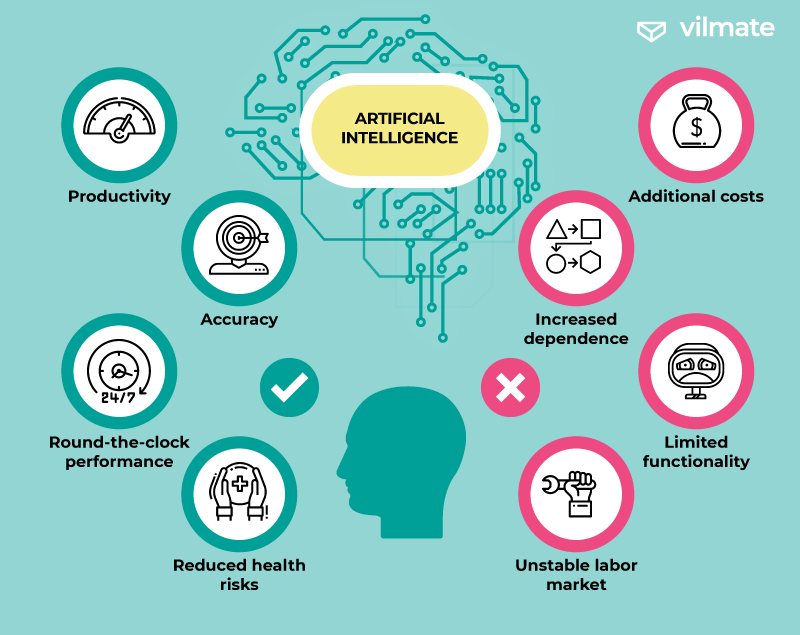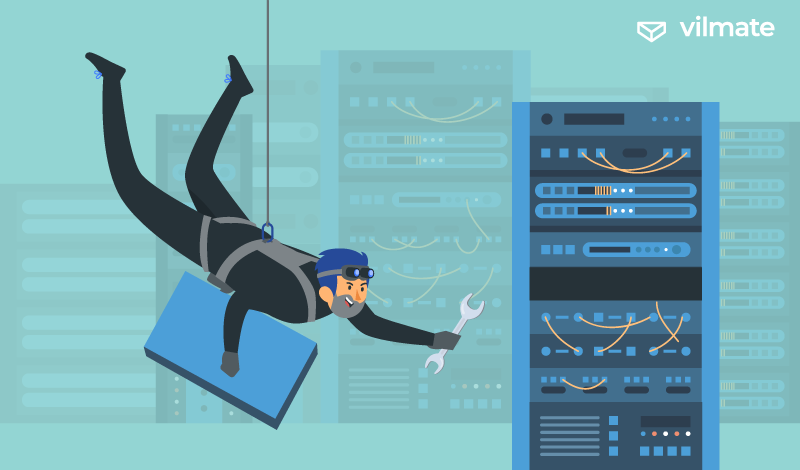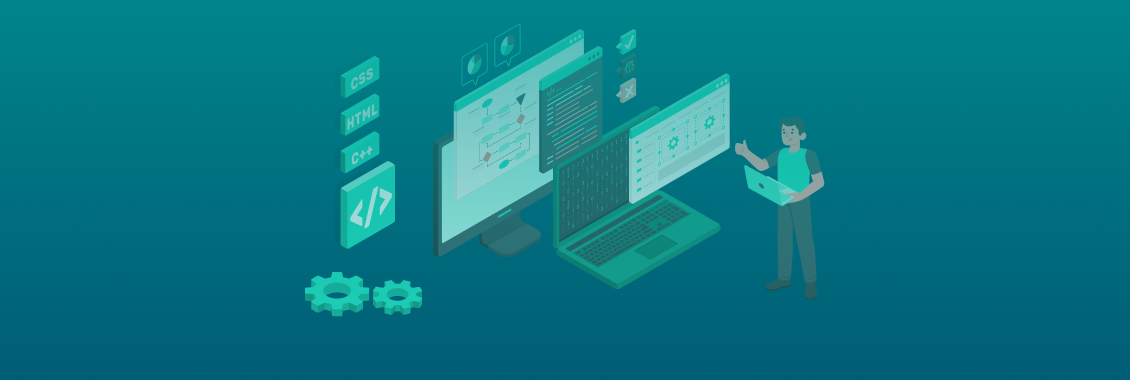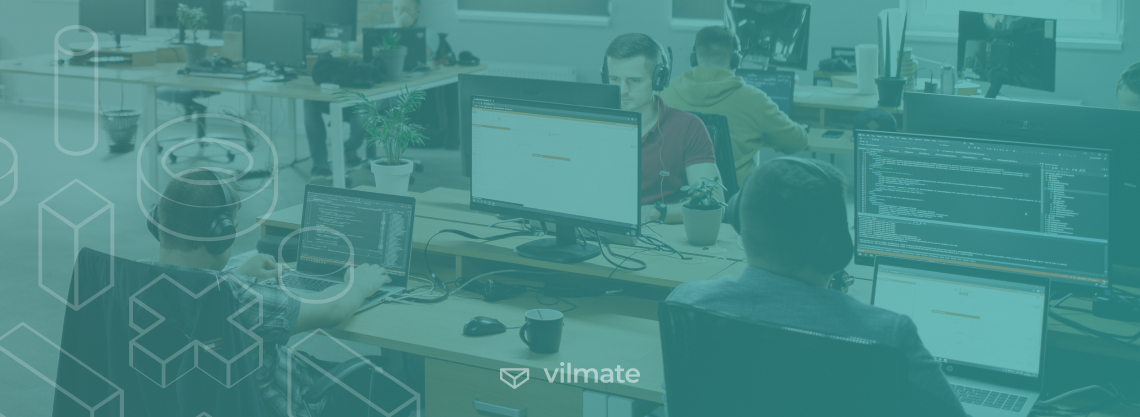It’s critically important for IT companies to keep up with new trends. A modern approach and the latest developments allow us to offer customers the most technologically advanced solutions. Specialists who study trends can easily predict them and even set new directions in the industry. It’s these companies that receive both monetary benefits and an impeccable reputation. And small hobby startups become full-fledged unicorns.
Before you start discovering the trends of 2023, it’s helpful to look back. Let’s dive into the study of the trends of the outgoing year and understand the lessons IT companies have learned for themselves.
Artificial intelligence (AI)
You have probably noticed how fast artificial intelligence is developing. And just 70 years ago, it existed only in the ambitious ideas of Alan Turing. But today we’re witnessing significant results from the implementation of AI.
Of course, artificial intelligence has become the primary IT trend of 2022. According to experts, by 2030, technology will contribute $15.7 trillion to the global economy. And this, by the way, is 26% of the world’s GDP.
Neural networks, as an AI method, have shown impressive results. The most outstanding example of 2022 was the Midjourney neural network, which learned how to draw amazing pictures from a text description, and the notorious DALL-E, which users appreciated for its friendly interface.
Neural network art pieces have created a resonance in the design community, as some works are already difficult to distinguish from human paintings.
Nvidia’s StyleGAN generative neural network can generate the face of a non-existent person. Stable Diffusion causes 200 images in different styles from your photo through the Lensa platform. And on the Me in Comics platform, everyone turns themselves into anime characters.
Naturally, neural networks have mastered the skill of writing texts and conducting believable dialogues. The most relevant example is chatGPT. And these are the platforms available for the public. What happens behind the curtains is up to our imagination.
AI is spreading into all spheres of our lives. Home appliances, smart devices, military technology, medicine – artificial intelligence is beneficial for any of these areas.
So while some users continue to worry about the rise of machines, enterprising tech companies are developing ways for AI implementations to free our lives from mundane routines.
But what about jobs? Will computers be able to replace humans in all areas completely? The World Economic Forum has already presented relevant studies. They say that 85 million jobs will be lost due to the rise of artificial intelligence, while 97 million are expected to be created. And for the most part, these emerging jobs will relate to the IT sector. The world will need more developers, testers, and software engineers of many kinds.
Let’s look at the advantages of artificial intelligence:
- Productivity. Artificial intelligence works faster and more accurately than humans. A machine can complete a task that would take two hours for a human in just a few seconds.
- Accuracy. Computer technologies based on artificial intelligence exclude human errors. Machines aren’t stressed or tired; their attention cannot be defocused. Everything that the computer does is based on logic, not emotions.
- 24/7 working routine. Machines don’t get tired, they don’t need to rest. It means they can work around the clock but with proper maintenance.
- Less risk to humans. In some hostile-environment productions, a person’s life can be put at risk. While a machine made of durable materials and applied with AI filling can take care of some complex tasks without putting anyone in a dangerous situation.
The problems of artificial intelligence are also quite weighty:
- Price. The costs of design, maintenance, and even deployment of artificial intelligence technology are far from low. In this regard, it’s too early for small businesses to consider the transition to AI. It will take some time till the technology is truly ubiquitous.
- Addiction. As artificial intelligence enters the major spheres of our lives, we’re gradually forgetting how to live without it. Dependence on technology is growing, which can negatively affect people’s cognitive and physical abilities in the long run.
- Limitation. Applications with artificial intelligence are quite capable but often single-tasked. And due to the lack of practical experience, they can only generate something new relying on the previous content. Don’t expect significant breakthroughs from AI yet. Though the practice of machines teaching new machines is also becoming common.
- Labor market. The development of artificial intelligence will deprive many specialists of jobs. New horizons will open in the IT space, which can be quite stressful for some people to get on with them. However, the world already experienced a similar crisis during the Industrial Revolution. Humanity is adaptive for the most part, though there are always people who prefer things the old-fashioned way. However, it’s not the time to talk about large-scale reductions due to the above-mentioned high cost of AI.

With that said, artificial intelligence has plenty of supporters and haters. But it will be mainstream in the future for sure.
IoT
Similar to artificial intelligence, IoT (Internet of Things) is a familiar idea. However, in 2022, it has remained an IT trend. In 2019, more than 26 billion IoT devices were in use worldwide. Due to the COVID-19 pandemic, interest in the Internet of Things has stalled. In 2022 it gained its second breath.
In 2020, each person had 4 devices connected to the Internet on average. And by 2022 the number has doubled. The reason is the spread of the Internet to the countryside worldwide.
IoT devices are often a part of smart home systems, including lights, refrigerators, locks, etc. In 2021, Apple fueled the growing interest in smart device integration by introducing the
HomePod mini and the updated Apple TV, teaching Siri to control devices from related companies.
In many ways, the use of smart devices has increased due to innovative wireless technologies, including Wi-Fi, Bluetooth, and 5G (also a 2022 tech trend).
The Internet of Things covers the fields of medicine, transport, manufacturing, military affairs, traffic infrastructure, and it keeps developing in these areas.
But so far, the main problem of IoT is security, which leads us to the next point.
Cybersecurity
Cybersecurity is an IT classic that will never stop buzzing. The cybersecurity market promises to have reached $366 billion by 2028.
In 2022 this area was addressed with the highest priorities. Obviously, along with advanced solutions, the danger of cyber threats is also growing. The problem is that large enterprises can afford to be more or less prepared for unwanted breaches, but the fair share of such attacks are directed at mid- and small- scale companies.
At the same time, the threat exists not only for businesses but also for ordinary users. In 2022, developers created new (and improved the antecedent) cybersecurity solutions that included blockchain approaches, zero-knowledge proofs, homomorphic encryption, and combating open-source vulnerabilities.
Let’s take a look at some of the innovations in this area.
Hacker-Proof Encryption
In 2022, experts continued to solve the cybersecurity problem at the quantum computing level. The technology is based on QKD – quantum key distribution method.
The essence of the technology is similar to modern email encryption. But QKD includes a key that decrypts the message. At the same time, the technology uses cryptographic protocols related to quantum mechanics. The main advantage is that QKD can detect third parties thanks to superposition, the same one used by Schrödinger in the thought experiment with the cat.
Uncrackable keys encrypted using quantum technology can fit on a microchip and fully protect the server. The hacker will have no choice but to infiltrate the facility and steal the data personally, like in spy movies.

AI-powered cybersecurity
Here we go again. There was no doubt that artificial intelligence would overtake the sphere of cybersecurity. As the main IT trend of 2022, AI has become an essential link in the fight against crime.
The problem with cybersecurity is that the attacker is always one step ahead. Cybersecurity is about constant defense. But AI is a game changer.
It turned out that programs based on artificial intelligence can notice signs of an attack at the earliest stages. Much faster than a person or any other modern technologies can do.
The computer can analyze and process large amounts of data, allowing to predict scenarios and work ahead of the curve.
In addition to detecting an attack, the AI can begin to prevent it before it enters the terminal stage.
The AI will immediately alert the specialist responsible for cybersecurity to join in repelling the attack.
We talked about the benefits of AI above. And in cybersecurity, they blaze in all their glory.
Web3
It’s too early to talk about the mass distribution of Web3. It’s just the possible future model of the Internet. But it began to penetrate the public space more and more often. The decentralized Internet gives users greater control over their data and strict ownership of digital assets. It will play a significant role in terms of cybersecurity as well.
However, if you are interested in IT trends of 2022, to properly invest in 2023, it’s worth exploring Web3 in more detail, especially while there are so many uncovered areas, immature interfaces, and different platforms at their dawn.
AR/VR
Virtual reality appeared long ago, and many people have already buried this technology for themselves. Many IT companies have abandoned work with AR and VR due to the lack of valuable ideas for application.
Everything changed in 2020 when the AR/VR market suddenly grew by 78.5% compared to 2019. And in 2022, the digital headset market grew by 92.1% compared to 2021!
VR found itself in games and excursions, and played a significant role in military affairs, e.g., training the US Army and Navy.
And if we are still waiting for a large-scale rise of VR, AR became a popular IT trend in 2022, having found its application in many areas. Let’s quickly look through some of them.
Modernized navigation solutions
AR can do things that GPS can’t. At least a lot of developers in 2022 put effort in creating alternative pedestrian navigation, which promised to be better than classic GPS. For example, AR can bring you to the right shelf in the store, help you find luggage at the airport or an Uber car that has arrived.
If the technology goes further, we will eventually get AR glasses that overlay the route in our field of view.
The Future of Online Shopping
Have you ever given up shopping online because you couldn’t try on clothes or get the idea of how the furniture would look in the interior? AR will remove all barriers between you and the new thing. More and more retail stores offer users to test the product virtually before buying.
And at least 71% of consumers liked it. And 61% of buyers said they would prefer a seller who implements AR technology.
Therefore, such companies as Adidas and Macy’s have already begun work on virtual fitting rooms. Moreover, Ikea and Target have invested in the technology that will allow users to see how furniture fits their premises. And even Apple had some fun with AR, allowing users to look at the new iMac Pro at their workplace.
Smart training
Augmented (extended) reality offers comfort and entertainment and can become an indispensable product in healthcare and engineering. Thanks to this technology, specialists can undergo visual training, which surgeons in some countries already apply.
New learning and teaching approaches combined with AR supplement theoretical knowledge with practice. And this opens up new opportunities for advanced and accelerated training of new specialists.
Driving safety
Incorporating augmented reality into advanced Heads Up Displays (HUDs) in 2022 has become a trend of IT companies partnering with Mercedes Benz and Tesla.
AR helps the smart car notify drivers of road obstacles and directions for movement. It’s true to say that driving safety will soon reach a new level.
Mercedes Benz HUD AR helps the computer to control the car and prevents rollback and rear crashes. Tesla cars, in their turn, can interact with obstacles with the help of AR as well.

Mutual understanding
Google Translate has already shown how to use smartphone cameras for real-time online translation. So far, the technology could be better, but in 2022, many IT professionals contributed to this issue. Likely, we will soon see augmented reality glasses that can translate in real-time. Travelers and students will surely rejoice at this, and technology will erase the boundaries between people from different countries even more.
Mutual understanding between people is lovely. But just as important is the interaction between the person and the device. The simplification of this communication is another trend in those areas.
NUI
NUI is the natural user interface. In 2022, the IT industry began to pay more attention to this matter.
The simplicity of software has a huge impact on widening the target audience. Therefore, more and more IT companies are releasing products with an intuitive user interface.
A significant revolution in this area is the emergence of touch screens.The Nintendo Wii gaming system, which works with sensors, accelerometers, and gyroscopes is also a good example.
The development of voice control applications and devices is also among the latest trends. So fresh ideas in a natural user interface were in demand in 2022 and there is more to come.

Cloud technologies and the related alternatives
Cloud platforms provide users with computing power, large storage, and large-scale data centers. Previously the cloud was used by users mainly for data storage, but in 2022, this IT trend continued to develop in many different directions. IaaS, PaaS, and SaaS solutions are suitable for various IT segments. According to surveys, 94% of companies used cloud solutions in 2022.
But there is one problem. Cloud computing is quite expensive and requires a lot of resources. For companies that work with large amounts of data this is critical.
Therefore, another direction became even more promising among the IT trends of 2022. Of course, we’re talking about edge computing.
This method allows reducing transmission bandwidth. By doing so, companies can provide their customers with a better user experience.
IT professionals are working on data reduction in order to increase the processing speed. The technology determines the importance of a bit to move the information to the appropriate server. Workload distribution allows you to:
- speed up data processing
- ensure data autonomy
- enhance security
- prevent delays
- make resources productive
Edge technologies will speed up current processes and allow new technologies to develop. The AR technology we’ve discussed above requires fast data processing. By the way, the cloud gaming service Google Stadia, with a great idea, failed precisely because of the computing power and the lack of reliable peripheral technologies.
Conclusion
The main IT trends of 2022 that we discussed are just the tip of the iceberg. There were a lot of exciting developments. Based on the lessons that IT companies learned in 2022, it’s easy to predict future in-demand technologies.




